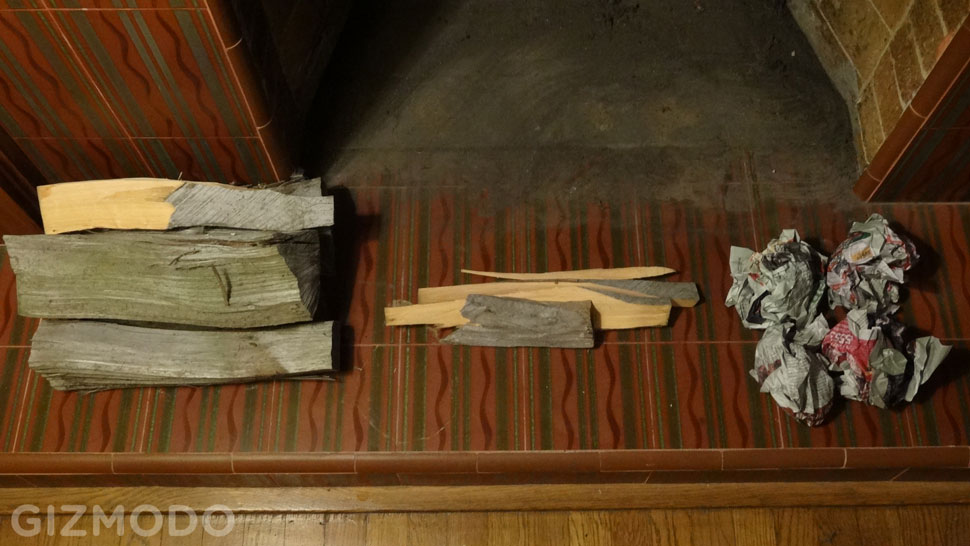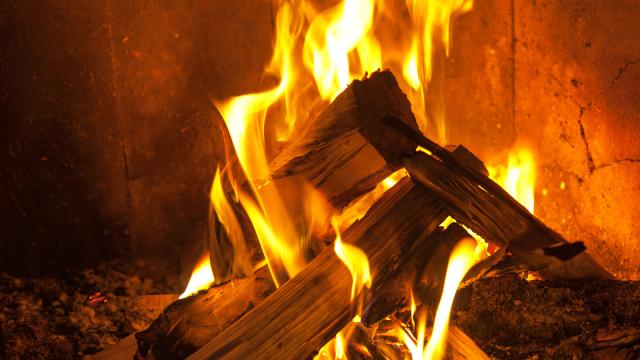There’s nothing quite like logs roaring in the hearth, but nobody wants to turn a winter warmer into a house fire. Here’s how to properly and responsibly start up a fire log without resorting to Firelighters (because really, that’s just cheating.)
Get Ready
First, if you’ve been using the hearth regularly this winter, grab a small shovel or trowel and scoop out any remnant charred wood and ash into a brown paper bag for disposal. Next, ensure that the chimney flue — the interior tube that carries smoke up and out of the home — is open and clear of obstructions such as birds nests, Creosote, and fat guys in red suits from last Christmas.
Also take a moment to ensure that you have a sufficient number of long handled matches, a fire extinguisher, log handling tools — a poker is nice, log tongs are better — and a hearth screen to prevent sparks from flying out and igniting your carpet. If you’ve got a ratty old welcome mat laying around somewhere, you might want to lay that out in front of the fireplace juuust in case.

Break It Down
You can’t just throw a couple of logs into the hearth, strike a match, and expect anything to happen. Fires don’t work that way. You have to build them up slowly from smaller flames. To do this, you will need three classes of fire-starter: tinder, kindling, and fuel logs.
Tinder is the fast-burning combustible stuff you use to get a fire initially started — lightly wadded news or wrapping paper works wonderfully. Kindling is more robust stuff that uses the tinder’s initial energy to get going, but will burn far longer and stronger, allowing you to slowly build up and maintain the fire until you can start tossing fuel logs on there.
Your kindling supply should consist of branches and split logs ranging in thickness from roughly a finger to roughly a wrist. Softwoods like pine make great kindling as their sappy interiors will easily ignite. You’ll want to keep a good amount of kindling on hand, not just to get the fire going initially but also in case it dies down and you have to jump start the process again.
Finally, there are the fuel logs. These large diameter chunks of wood require more energy to ignite, but once they do, will burn for hours (depending on the type of wood). Hardwoods like oak or walnut make for fantastic fuel logs, burning far longer and far hotter than softwoods. And while you don’t necessarily have to strip the exterior bark from fuel logs, you’ll do well to at least split them in half, exposing the more easily-burning interiors to the flames. You’ll need roughly two to three fuel logs for every 60-90 minutes of burn time.

Pop in an Oak
Fires require three elements to maintain combustion: fuel (the tinder, kindling, and logs), a spark (from matches or a lighter), and oxygen. The first two are easy but to allowing a fire to “breathe” properly — drawing oxygen up from the base of the fire while expelling hot gases from the tips of the flames — takes a bit of work. It all comes down to how you build the log structure.
The easiest structure is a simple lean-to. Take one fuel log, lay it along the side wall of the hearth, face open. This acts as the base of the structure. Wad up a few individual sheets of newspaper and tuck them in next to the base log. Next take a handful of your thinnest kindling and lay it atop the wadded newspaper, one end resting on the base log, the other sitting against the floor of the hearth. That’s the basic lean-to structure. Light up the newspaper, wait for the kindling to catch, then slowly add larger and larger kindling pieces until you’ve got wrist-thick pieces going. Then you can start laying other fuel logs on top of the base — just like you did the kindling — and boom, you’ve got yourself a toasty fire.

A slightly more complex variation of the lean-to is the log cabin structure — basically two lean-to’s facing each other. So, set a fuel log against either side of the hearth, ball up newspaper sheets and set them in between the base logs. Lay thin kindling pieces across the top of the newspaper, cross-ways from the base logs. Set fire to the tinder, and, just as before, continually lay increasingly thick pieces of kindling across the top before transitioning to fuel logs.
Once you have your fire going, maintaining it should be a simple matter — as long as you stay on top of the situation. If you notice the fire dying, throw some smaller kindling pieces (or even more tinder) on there to augment the larger fuel logs until they reignite.
Now some words on safety: don’t ever leave a fire unattended. Ever. And even if you’re in the room, use a hearth screen to keep errant embers from flying out and landing on something combustible — like your kids, your dog, your furniture, or your hair. Also keep that fire extinguisher handy, just in case.
If you do need to go out, make sure the fire is out first. First, let the fire die down to embers, then fill a pitcher with water and pour it over them to douse completely. A rule of thumb: if the ember’s red, it ain’t dead. Keep sprinkling water until everything in the hearth is sufficiently moist and cool to prevent spontaneous re-ignition — the charwood should be cool enough to touch when you’re done.
[Top image: Elena Pominova]
